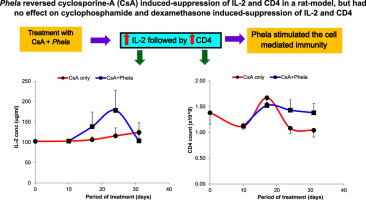Publication date: 12 July 2017
Source:Journal of Ethnopharmacology, Volume 206
Author(s): Makhotso Rose Lekhooa, Andrew Walubo, Jan B. du Plessis, Motlalepula Gilbert Matsabisa
Ethnopharmacology relevancyPhela, is code name for a medicinal product made from four South African traditional medicinal plants (Clerodendrum glabrum E. Mey, Polianthes tuberosa (Linn.), Rotheca myricoides (Hochst.) Steane & Mabb. and Senna occidentalis (L.) Link). All these plants have established traditional use in a wide spectrum of diseases. Phela is under development for use as an immune booster in immunocompromised patients, which includes patients with the human immunodeficiency virus (HIV). Already several studies, both pre-clinical and clinical, have shown that Phela is a safe and effective immune booster. Despite some studies on the action of Phela, the mechanism of action by Phela is still not known. Understanding the mechanism of action will enable safer and effective use of the drug for the right indications. Unfortunately, there is no well characterized test-system for screening products for immune stimulant activity. Therefore, the objective of this study was to use Phela as the test article, to develop and validate a rat-model (test system) by which to screen medicines for immune stimulant activity.Material and methodsFirst, the batch of Phela used was authenticated by high performance liquid chromatography (HPLC) techniques; analytical methods for the immunosuppressant drugs, cyclosporine A (CsA), cyclophosphamide (CP) and dexamethasone (Dex) were developed and validated; and a slide-A-Lyzer dialysis was used to test for potential interactions in rat plasma of Phela with CsA, CP and Dex. Thereafter, using Sprague Dawley (SD) rats and in separate experiments, the effective dose of Phela in the study animals was determined in a dose ranging study with levamisole, a known immune stimulant as the positive control; the appropriate doses for immunosuppression by CsA, CP and Dex were determined; the time to reach 'established immunosuppression' with each drug was determined (it was also the time for intervention with Phela); and eventually, the effect of Phela on the immune system was tested separately for each drug induced immunosuppression. The immune system was monitored by observing for changes in plasma profiles of IL-2, IL-10, IgG, IgM, CD4 and CD8 cell counts at appropriate intervals, while in addition to function tests, the kidneys, liver, spleen, thymus, were weighed and examined for any pathology.ResultsThe chromatographic fingerprint certified this batch of Phela as similar to the authentic Phela. There was no significant interaction between Phela and CsA, CP and Dex. The effective dose of Phela was determined to be 15.4mg/kg/day. Phela led to a moderate increase in the immune parameters in the normal rats. Co-administration of Phela 15mg/kg/day orally for 21 days with CsA led to stoppage and reversal of the immunosppressive effects of CsA that were exhibited as increased IL-2, IL-10, CD4 and CD8 counts, implying that Phela stimulates the cell mediate immunity (CMI). For CP, Phela led to stoppage and reversal, though moderate, of CP-induced suppression of IL-10, IgM and IgG only, implying that Phela stimulates the humoral immunity (HI) too. Phela had no effect on Dex induced immunosuppression. Stimulation of the CMI means that Phela clinical testing programme should focus on diseases or disorders that compromise the CMI, e.g., HIV and TB. The stimulation of the HI immunity means that Phela may stimulate existing memory cells to produce antibodies.ConclusionThe present study has revealed Phela's mechanism of action as mainly by stimulation of the CMI, implying that the use of Phela as immune booster in HIV patients is appropriate; and that using Phela as the test product, a rat model for screening medicinal products for immune stimulation has been successfully developed and validated, with a hope that it will lead to the testing of other related medicinal products.
Graphical abstract

http://ift.tt/2pEB7zq